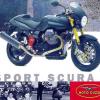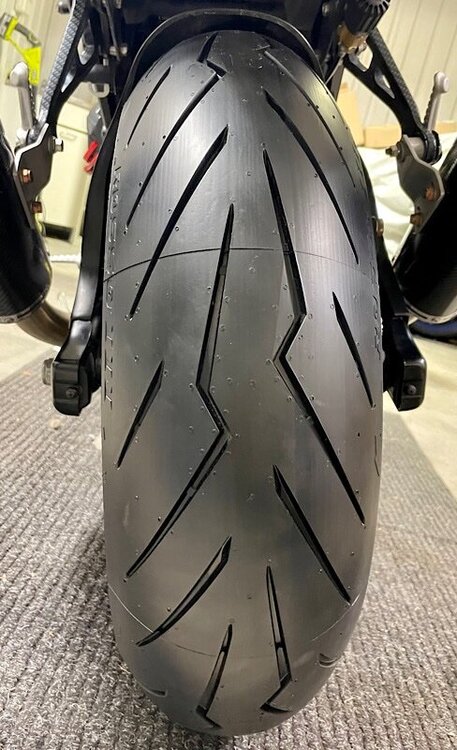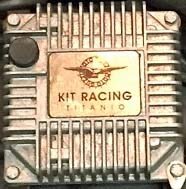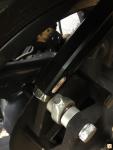-
Posts
154 -
Joined
-
Last visited
-
Days Won
4
Content Type
Profiles
Forums
Events
Gallery
Community Map
Everything posted by Camn
-
This is my second set of Rosso III (180/55-17). I have always used “sport touring (?)” type of tires on my V11. All around driving, mainly curvy roads, sometimes a careful beginners track day. “Good handling, sporty behavior.” Was rated the best in many tests in Europe back in 2017, now cheaper because of the age. Rosso IV is replacing these, I understand (already discontinued?). I have used also Metzeler Sportec M7 RR, Bridgestone S20 and Continental Sport Attack 2. And to be honest... "italian tires for italian bike...".
-

Basic metric sizes required to work on your V11? has anybody compiled a list?
Camn replied to p6x's topic in Technical Topics
This was educational - I had never thought, that seen from there (US) it is of course just the same as when we talk about Harleys here…Aargh… why do they have to use those funny measurements and make my life more difficult… -
I understand that the “Kit Racing Titanio” -labelled ecu which came with the “Titanium” kit was always the 15M with special mapping. For example the rpm limiter was at 8600 when the standard value is 8398 rpm (got this from Meinolf, have not checked myself). Here in my neighbourhood is a (rare) Nero Corsa with the original Guzzi Titanium Kit (Dynoed 86,2 hp/7926 rpm Crank). The software of this “Titanium Ecu” could not be uploaded to a 15RC ecu with the Guzzidiag Writer tool. The Nero Corsa came as new with 15RC and cats. The Titanium kit obviously contained “straight” absobtion type mufflers (made by Mistral I believe) without cats and the 15M ecu with ”race” mapping to go with the new parts on the exhaust.
-
Mee too. I have learned to trust this person, he is also on other German forums. Rides himself with a modified Centauro, a 4V and Spine Frame -specialist. I understand that he did work a long time within the official Guzzi organisation servicing Guzzis. He “broke in” all the new test bikes by riding them, so he was also “hands on” that way. It is very interesting to read his comments on spine frame Guzzis, he knows lots of details regarding different models and their technical solutions, including of course the V11 models. Had access to Piaggio data sources. A “scary moment” was to see the Scura number he mentioned. It has been mine the last 10 years (bought it from Germany). I have the complete owner history and he could tell what happened to this bike before it was sold as a new Scura originally (manufacturing date in Mandello, showroom time at the importer, etc.). Regarding the manufactured numbers; I tend to believe the numbers used here. Rosso Mandello, OK, 300+300 made, the first set numbered. Scura, 700 made, well registered here in “Scura registry”.
-
I have not met the owner, but I know that he is technically skilled and has had his California also supercharged earlier. But I have seen this Centauro at the previous owner & builder. "Power-wheelies were always at hand", I remember him quoting. He has also a blog, but in Finnish (google translate helps...). http://www.motomatti.fi/search?q=centauro Here are some lines of that blog: " Max constant boost pressure approx. 0.25 bar, momentary 1.7 bar. Exhaust pipe diameter 38 mm. · Footpeg- and pedal transfer kit, rear fender (carbon fiber) self-made · Ride Height adjustment, stepless, rear frame made of carbon fiber/steel structure, self - made · Rear cover, carbon fiber, design and structure, own design, seat has a carbon fiber frame, covering self-made · Marchesini rims, polished · Charging controller and audible signals moved to be located under the headlight, headlight raised, own design · Battery transferred to a separate housing behind the gearbox, housing made of carbon fiber, self-made · Mirrors at handlebar ends, normal accessory, exhaust system partly original, partly self-made · Mechanical supercharger Eaton M24, mounted to the left side of the motor, belt drive from the crankshaft, transmission approx. 2x · Pressure piping and pressure vessel, self-made, carbon fiber · Intake bodies original but with two pairs of nozzles (other pair from Ducati 996) · Cast pressure-resistant hoses from urethane for the intake bodies · Second injectors and their second ecu with pressure- and motor rpm -detection, connectors, relays and fuses MTA, waterproof · Display for the lambda value in additional instrument panel, instrument panel self-made, splash water-proof, in the same panel also a boost pressure gauge · Re-cirulation valve Forge, adjustable, temperature gauge for the charged air · Vacuum gauge, measures suction duct pressure " https://ibb.co/pXJGTyp https://ibb.co/MsLgZNk
-
I have been also following the German "mother forum" for GuzziDiag always. Some notes from there: " - you cannot upload the mapping of 15M to 15RC - copying the tables of the 15M into the 15RC is possible, the partially different addresses of the tables and scalars have to be taken into account (I understand that this means, that the copying of a single table from a bin file to another bin file is technically possible inside TunerPro, but the tables are not interchangeable with each other 1:1) - the contexts are much more complex and multi-layered on the 15RC than on the "simple" 15M, the key to understanding lies in the program code " So 15M/15RC mapping not interchangeable. If I remember right, the writer tool does not allow to write "a wrong map" into the ecu ? For example GuzziDiag does not connect, if a wrong ecu (like 15RC instead of 15M) is chosen.
-
Piaggio "Corporate Image" https://ibb.co/NrQ7cbp
-
I have always had the conception that the original ”chamber type” mufflers were made by Lafranconi. And the original Titanium -kit ”absorption type” mufflers by Mistral? But according Guzzi specs so that the ones Mistral is selling themselves, are not identical regarding the attachment to the tail pipe. I have the carbon oval version – it would be interesting to know how the Mistral oval titaniums differ from the Guzzi original (oval) titanium mufflers? I feel thalt the removable Db -killer is also a plus point on Mistrals, which can be finetuned according the liking of the user. For example I personally feel that the Db -killers off, the sound is a bit too loud, with the approved (CE) Db -killers on, too sniffy.
-
Meinolfs last comment on the air intake on the German forum / March 2018: http://www.guzzi-forum.de/Forum/index.php?topic=42323.0 " . . . Such changes become visible only, if the performance is measured on a test bench before/after or the effects on the lambda value are measured while riding. I had practiced that a few years ago on a V11. There was the "doctrine" that removing the intake snorkels of the air box provides significantly better air flow. A test based on lambda values showed the opposite. Without snorkels, lambda dropped in many throttle opening values. This means, that the air flow rate decreased and the mixture became more rich with the same amount of injection. My last modification to the snorkels was then the reshaping of the ends of the suction pipes to a bell shape, by means of hot air blower and beer bottle. And whether it was the shape or the beer, the air flow is now great . " I did not quite get it, if he means the "plastic pipes" themselves or the "rubber angles" in the end of the plastic pipes (what he made bell shaped). Mine is still 100% original. I had thought that if the "rubber angles" in the end would have a wider opening, maybe there could be a very slight "ram-air" effect. I don't mean that the possible ram-air effect would mean much with these pipe diameters (if I remember right, on the Sport 1100 i, with the ram-air intake pipes, the real benefit was not a lot).
-
Hi "BMEPdoc", (the Apriliaforum expert). (V11 Scura + Aprilia RSV C.E.R. on our backyard) Meinolf has spent "hundreds of hours" optimizing his V11 (with 15M ecu) and in reverse engineering the 15M "inner soul" on his "15M test board". Interestingly, as with the RSV CER, the stock airbox seems to be a good choice. https://www.v11lemans.com/forums/index.php?showtopic=19216&page=2 (Post #17)
-
The "Lucky Phil Extension Mod, made by Chuck" -owners club here in Finland would be eager to get such a retro-fit-kit :-)
-
I still have the Ducati Energia regulator, the 30A amp fuse doesn't like the huge amperage of it too much - the voltage seems to be OK, allthough I have a LiFePo -battery. " If using a thyristor type voltage regulator and it fails, upgrading to a mosfet based voltage regulator will offer longer lifespan and better charging system performance. Heat buildup in the voltage regulator kills the SCRs, whereas mosfets are more efficient and reliable. In general the mosfet design is better suited for the voltage regulator application demands. " https://shoraipower.com/index.php?path=&page=Overview-of-Voltage-Regulator-Types
-

Alps - Bike Rental Advice and Potential Riding Partner
Camn replied to Scud's topic in Travel & dealers
I did this trip actually few years ago...there are so many possibilities on the way... The greatest passes I rode were Stelvio and Gavia. @Scud: I sent your eMail address privately to Martin (V11 LeMans Tenni), who lives in Nürnberg. -

Alps - Bike Rental Advice and Potential Riding Partner
Camn replied to Scud's topic in Travel & dealers
I was "insolent" enough to link this to the bro's at the German V11 Forum. I surf around that Forum too, the guys there are as nice and friendly as the Guzzistas always are. -
As far as I understand, there are only two options left upwards (I have now 10 N/mm). Guzzi# (Öhlins-#)-XX: 04745 (08701)-80 / 8.0 N/mm 04745 (08701)-85 / 8.5 N/mm 04745 (08701)-90 / 9.0 N/mm * from factory * 04745 (08701)-95 / 9.5 N/mm 04745 (08701)-10 / 10.0 N/mm
-
Factory Spec Card is here:http://www.v11lemans.com/forums/index.php?showtopic=18805&page=7 (from Scud) "Spring 4745-90". 4745-90 = 9.0 N/mm.
-
Could it be this one from Grisoghetto? I remember also a known German specialist (HT-Moto, retired some years ago) saying me that it is not the clutch, it is the gearbox... But when the single plate clutch makes the noises vice versa (noisy when lever pulled)... " So let's get down and dirty with Guzzi clutches. Essentially they are fairly bulletproof. Sure, because they are bought from the cheapest supplier you can tell that they are built to pretty much the lowest acceptable standard but on the whole all of them, from the old twin plater used on the 2VPC models through to the single plate variants used on the 8V's and smallblocks, are pretty reliable - - and there was the horror story of the Scura single plater and the early Hydro Cali single plater in the 2003-4 period. Generally though, when compared to other marques problems these were rare, it's just they got talked about more because Guzzi owners, especially the Corn Cob Pipe mob are as verbose as @#!#$# and have forgotten that the 'Old Bikes' were nowhere as good or reliable as they remember! So, getting on to why your 'Clutch' on your 8V is 'Knocking' the simple fact is it isn't! The entire assembly on the 8V is fairly light. As the motor fires the crank accelerates and decelerates unevenly due to the firing sequence. The lighter the rotating mass connected to it, (Including not only the crank but the flywheel/clutch and the alternator belt and armature as well.) the less mass there is to act as a kinettic 'Battery' to store energy and even out the power pulses. When the clutch is disengaged, (Lever out.) the input shaft in the gearbox is also accelerating and decelerating with the crank etc. Unfortunately the secondary shaft and the output shaft pinions have no incentive to do the speed up/slow down thing! All they want to do is sit bloody still! So every time the input shaft speeds up it speeds up the input shaft and primary gear and then as it slows down the primary wants to keep spinning so the backlash in between the pinion teeth is smashed back and forth and it makes a knocking noise! It's NOT the clutch! Engage the clutch and the noise goes away beacause the input shaft, (Especially on a new bike where the seals on the 2RS bearings in the gearbox are still tight!) will slow to a halt or at least not have the power pulses to cause the hammering. This can also be exacerbated if the throttle body balance is out or the idle speed is too low. There is a reason why the target idle, (Several actually!) is 1250 +/-50 RPM! " https://www.grisoghetto.com/t3163-clutch-knocking-sound
-
My conception about the noise when the clutch lever is released (standard double plate clutch): When the clutch lever is released, following parts snug up and build up one “single” unit inside the flywheel: two friction plates, one intermediate plate and one pressure plate. This “single unit weight” is oscillating inside the flywheel (the outer gears of the pressure plate and intermediate plate against the inner gears of the flywheel) and makes the noise.
-
So, your Scura has a KS VIN? Is your number #672? => Yes. Are you saying Moto Guzzi changed to "KS" when the "LongFrame" was introduced with the additionally braced front subframe and lower rear subframe that connects forward to the bottom of the engine case => This was jut my thought – I have no facts about this. I had always thought, that “KR” = short frame, “KS” = long frame. Maybe a KS frame doesn't have fuel pump mounting tabs => You mean the version, where the fuel pump was sideways at the front? I have never checked or noticed these... I understand that all of the Scuras have the fuel pump outside the tank, but which location? There were three, I understand: under the tank, under the frame tube and sideways at the front. My #672 with the “KS” vin has the fuel pump under the frame tube (filter under the tank).
-
Here also, my understanding is, that allthough Guzzi used to continue the special "limited" series bikes if there was demand for them (like in the beginning, Rosso Mandellos had the number on the side fairing), all of the Scuras have their "limited edition number" on the top triple clamp. Since at those times (2002) the change from the KR chassis to the KS chassis took place, could it be, that the earlier bikes have the KR chassis and the later have the KS chassis? Do the "KR" Scuras have the added chassis parts? How high is the "limited edition" number of a Scura, which has the "KR" -vin (a KS "S672" has a mfg date 28.6.2002 - a dealer can look up the mfg date with the vin). Or could it be, that all the Scuras to the US all have the "KR" vin? The "answer" for my vin says "V11 SPORT SCURA CEE", to be precise. "CEE" like "Central and Eastern Europe" (the bike was delivered originally to a German dealer). The sticker on the frame also includes "CEE" and the ZGUKS..." vin.
-
As far as I know, all the Scuras are "KS" bikes (for example Rosso Mandellos were still "KR"). All Motors of all V11s are "KR". If you type your VIN here: http://static.piaggio.com/recall/form-piaggio_en.html, you should get as an answer: "The sent VIN number is: ZGUKSXXXXXXX….This chassis number corresponds to vehicle V11 SPORT SCURA..." Here's the official spare part catalogue, where all the Scura specific parts are separately marked: http://www.af1racing.com/store/ProdImages/st3/GU013.pdf. These fine people (AF1 Racing) by the way have all the V11 official spare part catalogues there, downloadable as pdf -files...
-
I had always thought, that the windshield is identical on V11 models, but according the original Piaggio spare part books the spare part numbers look like this: 1999-2001: GU01575 340 Windshield (apparently this was optional, the first grey on the picture above?) 2001-2002: GU01977 240 Windshield assy, Sport Nacked [sN] GU01977 275 Windshield assy.black, Scura 2003-2005 GU01575 380 Windshield assy.chr.yellow, Cafè Sport [C.S.] GU01575 382 Windshield assy.red, Ballabio Red 2003 [b.R.] GU01575 383 Windshield, cpl, Ballabio Grey 2003 [b.G.] GU01575 384 Windshiled, black/red, Scura R [s.R.] GU01575 388 Windshield assy, red/silver, Italian Cup [C.I.] I thought that this would have been the same also, but apparently not: GU03575 365 Windshield, cpl, California Alum./Tit. 1100 2003-2004
-
On mine (external regulator) the pressure was 3,2 bar when I measured it.
-
I remember having seen a case with an after market reaction rod also on a German forum. On the other hand, on Daytona and early Sport1100 (pre injection models) a similar solution was in use.







